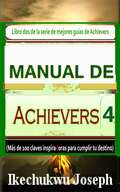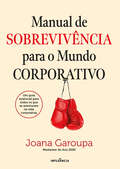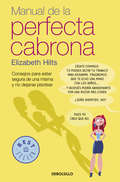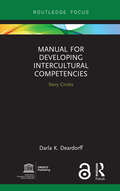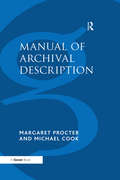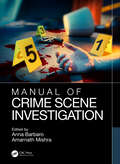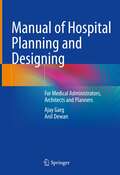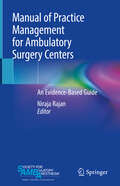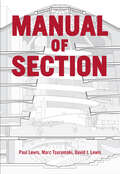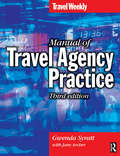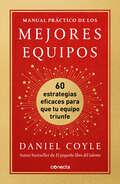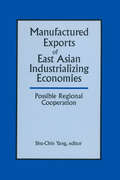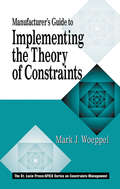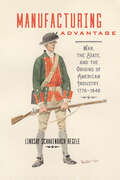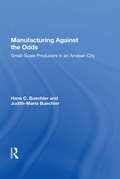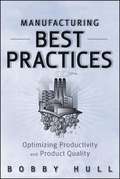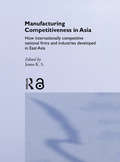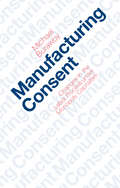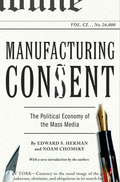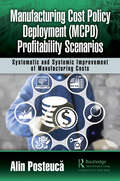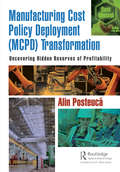- Table View
- List View
Manual de Achievers 4: más de 100 claves inspiradoras para cumplir tu destino (Serie de mejores guías de Achievers #4)
by Ikechukwu JosephManual de Achievers 4 Serie de mejores guías de Achievers 4 es una continuación del libro uno, dos y tres y contiene más de cien claves inspiradoras y motivadoras y pepitas de éxito que lo ayudarán a cumplir su Destino y aprovechar su potencial. Es una llamada de atención para cualquiera que quiera sobresalir en la vida. Este libro le ayudará en las estrategias de resolución de problemas, a descubrir y aprovechar su potencial. Este manual, manual de negocios y resúmenes de éxito es una lectura obligada y excelente para aquellos que desean cumplir sus sueños. Es para gente de negocios, triunfadores, innovadores, consejeros, entrenadores de vida, líderes, trabajadores, pastores, etc.
Manual de Sobrevivência Para o Mundo Corporativo
by Joana GaroupaJoana Garoupa foi eleita Marketeer do Ano em 2020, e considerada uma das melhores marketeers com quem trabalhar em Portugal (Scopen. O universo empresarial pode ser um lugar difícil. Os níveis de exigência são altos e o ritmo é imparável, cada decisão tem impacto no contexto em redor, e podemos perder o rumo - sejamos nós gestores, colaboradores ou estagiários. Joana Garoupa não é estranha a esse mundo. Iniciando-se cedo na vida corporativa, a sua experiência serviu-lhe para perceber o que é necessário para vingar nesse meio. «Joana é, sem dúvida, uma força que nos impele a ir mais além, e este livro espelha a sua força de acreditar, principalmente em nós próprios. E sei que este seu livro será um guia para muitos de nós.» — Sandra Anastácio, Presidente da Ajuda de Berço «Muito bem escrito, sobre temas relevantes.» — Fernando Neves de Almeida, Country President da Boyden Portugal «Gostei muito. Não sabia bem o que ia encontrar, mas acho que está bastante equilibrado: um conjunto de ferramentas alicerçado na experiência pessoal.» Hugo Figueiredo, Administrador da RTP «Um excelente compêndio prático.» — Carlos Gomes da Silva, Vice-presidente do MCA Group «Aprender com o erro, liderar com verdade, rodear-se de pessoas melhores, saber dizer não, agradecer e negociar — eis o que pode aprender neste livro com a rica experiência empresarial da Joana.» — Pedro Dionísio, Professor Catedrático na ISCTE Business School, coautor de Mercator e Publicitor «Certamente a ser lido, mais do que por quem quer sobreviver, pelos que dirigem as grandes organizações e companhias. Devem aprender também, pois só assim serão verdadeiros líderes» — Luís Mergulhão, CEO Omnicon Media Group Portugal «Um óptimo guia não só para os que estão a começar, mas também para os que precisam de relembrar estas temáticas» — Vera Curado, mentee PWN
Manual de la Perfecta Cabrona: Consejos para estar segura de una misma y no dejarse pisotear
by Elizabeth Hilts«Cásate conmigo. Tú puedes dejar tu trabajo para ayudarme. Fingiremos que te echo una mano con los niños... Y después podría abandonarte por una mujer más joven. Sería divertido, ¿no?» «Pues yo creo que NO.» A muchas mujeres las han educado para actuar siempre de la manera «correcta». Sin embargo, ese esfuerzo no solo no las hace felices, sino que incluso les impide alcanzar lo que desean. Pero en cada mujer existe una fuerza fundamental y poderosa que muchas veces preferimos ignorar. Es valiente, no se anda con paños calientes, no se deja pisar... Toda mujer lleva una «cabrona» dentro, conseguir que emerja para ayudarnos a vivir mejor es solo cuestión de que aprendamos a escucharla y seamos capaces de superar nuestros miedos. Con humor e ingenio, Elizabeth Hilts nos ofrece en este libro los consejos básicos para que, de una vez por todas, la cabrona tome el mando. La crítica ha dicho...«Soy enérgica, ambiciosa y sé exactamente lo que quiero. Si eso me convierte en una cabrona, pues vale.»Madonna «Cásate conmigo. Tú puedes dejar tu trabajo para ayudarme. Fingiremos que te echo una mano con los niños... Y después podría abandonarte por una mujer más joven. Sería divertido, ¿no?» «Pues yo creo que NO.» A muchas mujeres las han educado para actuar siempre de la manera «correcta». Sin embargo, ese esfuerzo no solo no las hace felices, sino que incluso les impide alcanzar lo que desean. Pero en cada mujer existe una fuerza fundamental y poderosa que muchas veces preferimos ignorar. Es valiente, no se anda con paños calientes, no se deja pisar... Toda mujer lleva una «cabrona» dentro, conseguir que emerja para ayudarnos a vivir mejor es solo cuestión de que aprendamos a escucharla y seamos capaces de superar nuestros miedos. Con humor e ingenio, Elizabeth Hilts nos ofrece en este libro los consejos básicos para que, de una vez por todas, la cabrona tome el mando. La crítica ha dicho...«Soy enérgica, ambiciosa y sé exactamente lo que quiero. Si eso me convierte en una cabrona, pues vale.»Madonna
Manual de oro para reuniones diarias con fuerza de ventas: Selección de experiencias reales orientadas como un facilitador para personas qu
by Jorge Ávalos ConchaTe reto a explorar las mejores técnicas para formar equipos de élite y dominar tu mercado. Recopilación única en el mercado actual de experiencias reales y prácticas, que concentra ochenta y cuatro temas listos y orientados a las reuniones de las personas que lideran equipos de ventas. No es lo mismo un material teórico que uno realizado por alguien que vivió a fondo la experiencia de todos los cargos durante la mayor parte de su vida laboral, cuyas vivencias reales hoy tiene a su disposición y son el resultado de una larga trayectoria exitosa. En la práctica, decide la problemática que su equipo necesita abordar, va al manual, busca el capítulo, selecciona el tema, lo lee, se familiariza y lo presenta, con lo que los apoyará, formará, controlará y motivará, a la vez que potenciará su imagen de liderazgo.
Manual for Developing Intercultural Competencies: Story Circles (Routledge Focus on Environment and Sustainability)
by Darla K. DeardorffThis book presents a structured yet flexible methodology for developing intercultural competence in a variety of contexts, both formal and informal. Piloted around the world by UNESCO, this methodology has proven to be effective in a range of different contexts and focused on a variety of different issues. It, therefore can be considered an important resource for anyone concerned with effectively managing the growing cultural diversity within our societies to ensure inclusive and sustainable development. Intercultural competence refers to the skills, attitudes, and behaviours needed to improve interactions across difference, whether within a society (differences due to age, gender, religion, socio-economic status, political affiliation, ethnicity, and so on) or across borders. The book serves as a tool to develop those competences, presenting an innovative adaptation of what could be considered an ancient tradition of storytelling found in many cultures. Through engaging in the methodology, participants develop key elements of intercultural competence, including greater self-awareness, openness, respect, reflexivity, empathy, increased awareness of others, and in the end, greater cultural humility. This book will be of great interest to intercultural trainers, policy makers, development practitioners, educators, community organizers, civil society leaders, university lecturers and students – all who are interested in developing intercultural competence as a means to understand and appreciate difference, develop relationships with those across difference, engage in intercultural dialogue, and bridge societal divides.
Manual of Archival Description
by Michael Cook Margaret Procter’MAD3’ is the third and latest edition of the influential Manual of Archival Description, revised to take account of a decade of developments in national and international descriptive practice. Many improvements have been made as a result of wide consultation with archive professionals. The Manual remains the only comprehensive British guide to the theory and practice of listing archives held in any format, from letters, photographs and maps to electronic multimedia. New features of this edition include: ¢ additional information on national and international standards which have appeared since the last edition, including data elements mapped to the General International Standard Archival Description - ISAD(G) - which appears as an appendix ¢ coverage of developments in archives administration theory and new access delivery initiatives ¢ extensive updating of sections covering audiovisual material ¢ rewritten chapter on electronic archives ¢ updated dictionary in line with the 1999 ICA definitions ¢ additional examples of listing practice. This standard, authoritative guide to listing and cataloguing is for both generalist repositories and other organizations with archives to manage. As online cross-repository searching becomes a reality, the new edition will enable both professional archivists, records managers and other information professionals to standardize archive listing.
Manual of Crime Scene Investigation
by Anna Barbaro Amarnath MishraOver the past several years, myriad manuals on crime scene investigations have been published with each focusing on select, or partial, aspects of the investigation. Crime scene investigation, done right, is a multi-faceted process that requires various forms of evidence to be collected, examined, and analyzed. No book available has addressed procedures to present global best practices by assembling a collection of international experts to address such topics. Manual of Crime Scene Investigation is a comprehensive collaboration of experts writing on their particular areas of expertise as relates to crime scenes, evidence, and crime scene investigation. The book outlines best practices in the field, incorporating the latest technology to collect, preserve, and enhance evidence for appropriate analysis. Various types of forensic evidence are addressed, covering chain of custody, collection, and utility of such evidence in casework, investigations, and for use in court. The approach, and use of international contributor experts, will appeal to a broad audience and be of use to forensic practitioners, and the forensic science community worldwide. Key features: • Assembles an international team of contributing author experts to present the latest developments in their crime scene field of specialty • Examines global best practices and what are consistently the most reliable tactics and approach to crime scene evidence collection, preservation, and investigation • Provides numerous photographs and diagrams to clearly illustrate chapter concepts Manual of Crime Scene Investigation serves as a vital resource to professionals in police science and crime scene investigations, private forensic institutions, and academics researching how better real-world application of techniques can improve the reliability and utility of evidence upon forensic and laboratory analysis.
Manual of Hospital Planning and Designing: For Medical Administrators, Architects and Planners
by Ajay Garg Anil DewanThis book is a one-stop resource on all the critical aspects of planning and designing hospitals, one of the most complex healthcare projects to undertake. A well-planned and designed hospital should control infection rate, provide safety to patients, caregivers and visitors, help improve patients' recovery and have scope for future expansion and change. Reinforcing these basic principles, guidance on such effective planning and designing is the key focus. Readers are offered insights into eliminating shortcomings at every stage of setting up a hospital which may not be feasible to rectify later on through alterations. Chapters from 1 to 12 of the book provide exhaustive notes on initial planning, such as detailed project reports, feasibility studies, and area calculation. Chapters 13 to 27 include designing and layout of all the essential departments/units such as OPD, emergency, intermediate care, diagnostics, operating rooms, and intensive care units. Chapters 28 to 37 cover designing support services like sterilization department, pharmacy, medical gas pipeline, kitchen, laundry, medical record, and mortuary. Chapters 38 to 48 take the readers through planning other services like air-conditioning and ventilation, fire safety, extra low voltage, mechanical, electrical, and plumbing services. Chapter 49 is for the planning of medical equipment. A particular chapter on "Green" hospital designing is included. This book is a single essential tabletop reference for hospital consultants, medical and hospital administrators, hospital designers, architecture students, and hospital promoters.
Manual of Practice Management for Ambulatory Surgery Centers: An Evidence-Based Guide
by Niraja RajanThis key resource provides insight and guidance to managing ambulatory surgery centers (ACSs) from a broad spectrum of expertise. Intended for a wide audience of healthcare professionals, this book covers topics such as regulatory issues, outpatient pediatric anesthesia, inventory management, personnel training, the culture of safety, and sedation standards. The format found in each chapter is designed intentionally to function as an educational manual. Many chapters are supplemented by high quality figures and tables to aid in visual learning.This text brings together authors from diverse professions including lawyers, administrators, surgeons, anesthesiologists and architects – all of whom have contributed their expertise to address the multitude of subjects that pertain to ASCs. Manual of Practice Management for Ambulatory Surgery Centers: An Evidence-Based Guide is a concise and evidence-based guide to successfully operating the modern health care facilities that have transformed the outpatient experience for millions of people.
Manual of Section
by Paul Lewis Marc Tsurumaki David J. LewisAlong with plan and elevation, section is one of the essential representational techniques of architectural design; among architects and educators, debates about a project's section are common and often intense. Until now, however, there has been no framework to describe or evaluate it. Manual of Section fills this void.Paul Lewis, Marc Tsurumaki, and David J. Lewis have developed seven categories of section, revealed in structures ranging from simple one-story buildings to complex structures featuring stacked forms, fantastical shapes, internal holes, inclines, sheared planes, nested forms, or combinations thereof. To illustrate these categories, the authors construct sixty-three intricately detailed cross-section perspective drawings of built projects—many of the most significant structures in international architecture from the last one hundred years—based on extensive archival research. Manual of Section also includes smart and accessible essays on the history and uses of section.
Manual of Travel Agency Practice
by Jane Archer Gwenda SyrattNow in its third edition, this successful must-have manual is thoroughly updated with new chapters and material, covering issues including:* Technology development - the different types of travel agency systems available, what they do, how they do it and how to use them* The Internet - how it is used to book travel, forecasts for its future use and how travel agenets stand in relation to it* Global distribution systems - how to make bookings, and the new windows-based environment* A full endorsement by Travel Weekly The manual demonstrates correct methods for processing travel reservations, identifying business client needs and suitable documentation. It also shows key facts for the profitable planning, organization and operation of the retail travel agency. Each chapter contains exercises pertinent to the topics covered.Students on any of the large number of courses in travel and tourism (ICM, City & Guilds, ABTA, IATA, UFTAA, BTEC, SCOTVEC, University of Oxford Certificate, Diploma of Vocational Education) will find this book invaluable.
Manual on Fiscal Transparency
by International Monetary FundA report from the International Monetary Fund.
Manual práctico de los mejores equipos: 60 estrategias eficaces para que tu equipo triunfe
by Daniel CoyleLa guía definitiva para estimular y fomentar la mejor cultura de equipo.Un libro que perfeccionará las habilidades de cualquier líder y fortalecerá la cohesión de cualquier grupo. ¿En qué consiste una buena mentalidad de equipo?¿Cómo podemos sacar lo mejor de un grupo o mejorar aquel que lo necesita? Daniel Coyle lleva años investigando a equipos de élite de todo el mundo, estudiando cómo se apoyan, cómo gestionan los conflictos y cómo avanzan hacia un objetivo común. Los que mejor funcionan, explica, se basan en tres ejes esenciales: seguridad, vulnerabilidad y propósito. Manual práctico de los mejores equipos ofrece 60 tácticas sencillas para construir un entorno fuerte, cohesionado y positivo. Coyle incluye en estas páginas ejercicios que pueden llevarse a cabo en cualquier situación, como, por ejemplo:* Programar reuniones para hablar explícitamente del funcionamiento del equipo con el fin de mejorar la dinámica interna.* Crear espacios para que los trabajadores remotos estén conectados con el resto del equipo y cultiven una mentalidad de equipo a pesar de la distancia.* Celebrar fiestas que sirvan como válvula de escape y como plataforma para que la gente conecte y resuelva problemas en equipo. Repleto de ilustraciones en blanco y negro y de consejos prácticos útiles para empresas, atletas e incluso familias, Manual práctico de los mejores equipos es una guía indispensable para lograr que cualquier grupo rinda al máximo. Reseñas:«Si eres un líder, o si trabajas con uno, y quieres comprender cómo generar seguridad, confianza y un sentido de propósito para tu equipo, necesitas este libro».Charles Duhigg, autor de Más agudo, más rápido y mejor y El poder de los hábitos «Tu cultura de equipo = tus acciones. Con esta simple frase, Dan Coyle descifra el elemento más importante y complejo para crear los mejores equipos y ofrece acciones concretas para construir una cohesión increíble todos los días».Laszlo Bock, autor de La nueva fórmula del trabajo «Manual práctico de los mejores equipos ofrece un conjunto de ejercicios simples y efectivos para cualquiera que se plantee crear una cultura de equipo que permita prosperar y desempeñar el trabajo lo mejor posible. Marcadamente práctico, este es un libro de trabajo con un toque lúdico, y seguirlo ayudará a cualquier grupo a alcanzar el éxito».Amy C. Edmondson, docente en Harvard Business School
Manufactured Exports of East Asian Industrializing Economies and Possible Regional Cooperation
by Shu-Chin YangProviding an examination of civil-military relations in China, this book reflects the changes taking place in Chinese society and their impact on the civil-military dynamic. It explores issues, such as the impact of AIDS, the defense budget, the emerging dynamic between the military and China's leadership, the role of the militia, and more.
Manufactured Homes, Inc.
by Krishna G. PalepuFocuses on analyzing the growth potential of the company using the company's financial statements.
Manufacturer's Guide to Implementing the Theory of Constraints (The CRC Press Series on Constraints Management)
by Mark WoeppelEveryone in business today has heard of the Theory of Constraints (TOC), developed by Eli Goldratt in his groundbreaking book The Goal. However, very few people know how to implement it in a manufacturing organization. The Manufacturer's Guide to Implementing the Theory of Constraints answers all your questions and more.Written by Mark Woep
Manufacturing Advantage: War, the State, and the Origins of American Industry, 1776–1848 (Studies in Early American Economy and Society from the Library Company of Philadelphia)
by Lindsay Schakenbach RegeleHow manufacturing textiles and guns transformed the United States from colonial dependent to military power.In 1783, the Revolutionary War drew to a close, but America was still threatened by enemies at home and abroad. The emerging nation faced tax rebellions, Indian warfare, and hostilities with France and England. Its arsenal—a collection of hand-me-down and beat-up firearms—was woefully inadequate, and its manufacturing sector was weak. In an era when armies literally froze in the field, military preparedness depended on blankets and jackets, the importation of which the British Empire had coordinated for over 200 years. Without a ready supply of guns, the new nation could not defend itself; without its own textiles, it was at the economic mercy of the British. Domestic industry offered the best solution for true economic and military independence. In Manufacturing Advantage, Lindsay Schakenbach Regele shows how the US government promoted the industrial development of textiles and weapons to defend the country from hostile armies—and hostile imports. Moving from the late 1700s through the Mexican-American War, Schakenbach Regele argues that both industries developed as a result of what she calls "national security capitalism": a mixed enterprise system in which government agents and private producers brokered solutions to the problems of war and international economic disparities. War and State Department officials played particularly key roles in the emergence of American industry, facilitating arms makers and power loom weavers in the quest to develop industrial resources. And this defensive strategy, Schakenbach Regele reveals, eventually evolved to promote westward expansion, as well as America’s growing commercial and territorial empire. Examining these issues through the lens of geopolitics, Manufacturing Advantage places the rise of industry in the United States in the context of territorial expansion, diplomacy, and warfare. Ultimately, the book reveals the complex link between government intervention and private initiative in a country struggling to create a political economy that balanced military competence with commercial needs.
Manufacturing Against The Odds: The Dynamics Of Gender, Class, And Economic Crises Among Small-scale Producers
by Hans BuechlerIn Third World countries, small-scale manufacturers supply a large part of the nation's consumer goods, often meeting needs that larger operations of foreign imports cannot. Enlivened by the oral histories of women and men of rural and urban backgrounds, this book depicts the struggle of artisan and small-scale manufacturing enterprises in La Paz d
Manufacturing Best Practices
by Bobby HullWorld-class tools for businesses to create their own manufacturing best practices Providing best practices used throughout the manufacturing sector, Manufacturing Best Practices takes currently available manufacturing tools, such as six Sigma, Lean, ISO and Statistical Process Control (SPC), combined with real world experience, and shows how they can be used to create a culture or philosophy within an organization. Shows that it is not the tools that make best practices, but rather the mindset that can be developed through the use of the tools Provides best practices for manufacturers to pick those that are most applicable to their needs Written for CEOs, CFOs, controllers, and line managers in the manufacturing sector Manufacturing Best Practices closely examines the processes, protocols, and philosophies that are used in manufacturing so companies can create their own best practices scenario.
Manufacturing Competitiveness in Asia: How Internationally Competitive National Firms and Industries Developed in East Asia (Routledge Studies in the Growth Economies of Asia #Vol. 47)
by Jomo K. S.There are competing theories to explain the reasons behind the international competitiveness of manufacturing in Asia. Analysing these different theories will bring important lessons, not just for Asia, but for developing economies the world over.This lucid book studies industries and firms in East Asia and examines the major determinants of their economic performance. With contributions from such leading thinkers as Ha-Joon Chang and Rajah Rasiah, the book covers such themes as:*industrial policy and East Asia*Taiwan's information technology industry*The role of the government in technological capability buildingManufacturing Competitiveness in Asia touches on many important themes and issues and as such will be of great interest to students, academics and policy-makers involved in industrial economics, international trade and Asian studies.
Manufacturing Consent: Changes in the Labor Process Under Monopoly Capitalism
by Michael BurawoySince the 1930s, industrial sociologists have tried to answer the question, Why do workers not work harder? Michael Burawoy spent ten months as a machine operator in a Chicago factory trying to answer different but equally important questions: Why do workers work as hard as they do? Why do workers routinely consent to their own exploitation?Manufacturing Consent, the result of Burawoy's research, combines rich ethnographical description with an original Marxist theory of the capitalist labor process. Manufacturing Consent is unique among studies of this kind because Burawoy has been able to analyze his own experiences in relation to those of Donald Roy, who studied the same factory thirty years earlier. Burawoy traces the technical, political, and ideological changes in factory life to the transformations of the market relations of the plant (it is now part of a multinational corporation) and to broader movements, since World War II, in industrial relations.
Manufacturing Consent: The Political Economy of the Mass Media
by Noam Chomsky Edward S. HermanAn intellectual dissection of the modern media to show how an underlying economics of publishing warps the news.
Manufacturing Cost Policy Deployment (MCPD) Profitability Scenarios: Systematic and Systemic Improvement of Manufacturing Costs
by Alin PosteucaThis book shows how to consistently obtain annual and multiannual manufacturing target profit regardless of the evolution of sales volumes, increasing or decreasing, using the Manufacturing Cost Policy Deployment (MCPD) system. Managers and practitioners within the manufacturing companies will discover a practical approach within the MCPD system that will help them develop and support their long-term, medium-term, and short-term profitability and productivity strategy. The book presents both the basic concepts of MCPD and the key elements of transforming manufacturing companies through MCPD system, as well as supporting the consistent growth of external and internal profit by directing all systematic and systemic improvements based on meeting the annual and multiannual Manufacturing Cost Improvement (MCI) targets and means for each Product-Family Cost (PFC). <P><P>This book is unique because it presents two types of systematic and systemic improvement projects for MCI that have been applied over the years in various multinational manufacturing companies operating in highly competitive markets, in order to address the consistent reduction of unit manufacturing costs by improving the Cost of Losses and Waste (CLW). <P><P>Readers will discover the practical approach of MCI based on a structured approach to MCPD system beyond the traditional approach to manufacturing improvements based mainly on improved time and quality. Therefore, from the perspective of the MCPD system, the multiannual manufacturing target profits are met while the annual and multiannual manufacturing target costs are a predetermined stake and not a result of the improvements already made.
Manufacturing Cost Policy Deployment (MCPD) Transformation: Uncovering Hidden Reserves of Profitability
by Alin PosteucaAchieving a long-term acceptable level of manufacturing profitability through productivity requires the total commitment of management teams and all staff in any manufacturing company and beyond. Awareness and continuous improvement of manufacturing costs behind losses and waste is the core goal of the Manufacturing Cost Policy Deployment (MCPD). Achieving this goal will continually uncover the hidden reserves of profitability through a harmonious transformation of the manufacturing flow, coordinated by the continuous need to improve manufacturing costs. Setting annual targets and means for manufacturing costs improvement (more exactly for costs of losses and waste, and the exact fulfillment of these) requires mobilization of all people in the company to carry out systematic improvement activities (kaizen) and systemic improvement actions (kaikaku) of the processes of each product family cost. The MCPD system was born out of careful observation of the challenges, principles, and phenomena of manufacturing companies and the profound discussions with the people in these companies at all levels. Manufacturing Cost Policy Deployment (MCPD) Transformation: Uncovering Hidden Reserves of Profitability is organized in three sections. The first section presents the concept and the need for an MCPD system from a managerial perspective. In the second section, the transformation of manufacturing companies through the MCPD system is presented, more precisely the details of the initial steps of the implementation of the MCPD, the three phases and the seven steps of the MCPD, and the elements necessary for a constant and consistent application of the MCPD. In the last section, there are two examples of the MCPD implementation in two different types of industries, namely, manufacturing and assembly industry and process industry, and two case studies for the improvement of manufacturing costs for each (cost of equipment setup loss, using kaizenshiro; replacement of bottleneck equipment and associated costs of losses, using kaikaku; cost of quality losses with improving operators’ skills to sustain quality, using kaizen; and cost problem solving with the consumption of lubricants for one of the equipment, using A3).
Manufacturing Cost Policy Deployment (MCPD) and Methods Design Concept (MDC): The Path to Competitiveness
by Shigeyasu Sakamoto Alin PosteucaProviding a reasonable level of profitability through productivity is - and will remain - one of the fundamental tasks of the management teams of any production company. Manufacturing Cost Policy Deployment (MCPD) and Methods Design Concept (MDC): The Path to Competitiveness contains two new methodologies to improving the productivity and profitability of production systems that continuously increase competitiveness: Manufacturing Cost Policy Deployment (MCPD) and Methods Design Concept (MDC). Both MCPD and MDC are the result of long-time synthesis and distillation, being implemented successfully, totally or partially, in many companies. The MCPD system, developed by Alin Posteucă, is a manufacturing cost policy aimed at continuous cost improvement through a systemic and systematic approach. The MCPD is a methodology that improves the production flow driven by the need for Manufacturing Cost Improvement (MCI) for both existing and future products through setting targets and means to continuously improve production process productivity for each product family cost. The MDC, developed by Shigeyasu Sakamoto, design the effective manufacturing methods using a tool of engineering steps identifying ideas for increasing productivity called KAIZENSHIRO (improvable value as a target). The MDC results on production methods lead to effectiveness of work measurement for performance (P) and to knowledge and improvement of production control and planning as utilization (U), in order to achieve labor target costs. The combination of MCPD and MDC methodologies can provide a unique approach for the managers who are seeking new ways for increasing productivity and profitability to increase the competitive level of their manufacturing company.
